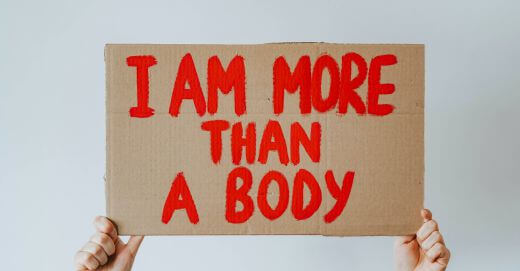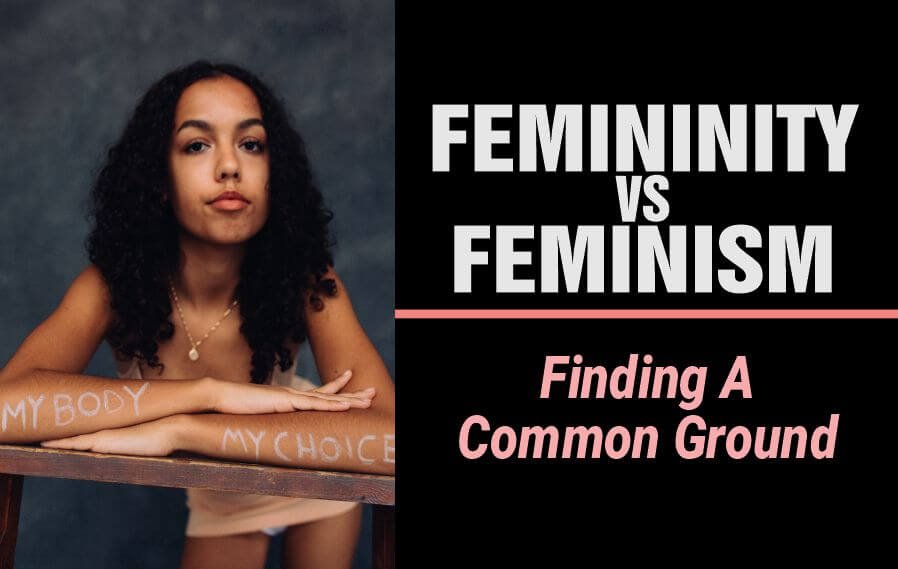Last updated on January 13th, 2024 at 08:38 am
Finding a common ground between femininity and feminism has been a topic of great debate in recent years. Here is how to reconcile the two.
Femininity, traditionally associated with societal expectations and gender roles, sometimes clashes with the fundamental principles of feminism, which advocates for equality between genders.
However, it is not inherently opposed to feminist beliefs and can play a crucial role in empowering women.
In today’s society, there is a growing realization that femininity can be redefined and embraced in ways that align with feminist values.
In this post, we will discuss the principles of feminism and femininity, their conflicts, and how they can be reconciled.
Suggested: What is Feminine Energy?
Table of Contents
- Overview of Femininity vs Feminism
- Core Principles of Feminism
- Historical Conflicts Between Femininity and Feminism
- Femininity in the Context of Modern Feminism
- Challenges in Reconciling Femininity and Feminism
- Embracing Femininity Within Feminism
- Conclusion
- Frequently Asked Questions
Overview of Femininity vs Feminism
The concept of femininity vs feminism is a complex and often debated topic. Femininity refers to the traditional societal expectations and stereotypes associated with being a woman, emphasizing traits such as nurturing, gentleness, and beauty.
On the other hand, feminism advocates for gender equality and challenges these traditional norms, aiming to empower women and dismantle oppressive structures.
There have been tensions and intersections between femininity and feminism, causing the struggles faced by women in navigating societal expectations while striving for equality.
While these two have been at loggerheads, there lies a common ground where both can thrive for the benefit of the woman and the world.
Related: Lady Etiquettes for Every Woman
Core Principles of Feminism

The core principles of feminism can vary depending on the specific branch or perspective within the movement, but some common principles include:
Gender equality: Feminism works towards dismantling the social, economic, and political barriers that limit women’s opportunities and strives for an equitable society where individuals of all genders have equal rights and access to resources.
Intersectionality: Recognizing that women’s experiences are shaped by various intersecting identities such as race, class, sexuality, disability, and more.
Related: How Gender Stereotypes Originated
Autonomy and agency: Feminism promotes women’s autonomy over their bodies, choices, and lives. It advocates for reproductive rights, sexual freedom, and the ability for women to make informed decisions without coercion or societal pressures.
Challenging gender norms: Feminism questions and challenges restrictive gender roles and expectations imposed on both women and men. It encourages the freedom to express oneself and break away from limiting stereotypes.
Solidarity and inclusivity: Feminism seeks to promote solidarity among individuals facing gender-based oppression and discrimination, emphasizing the importance of allyship and collective action.
Historical Conflicts Between Femininity and Feminism
The historical conflicts between femininity and feminism stem from the patriarchal societies that have traditionally imposed rigid gender roles on women.
This clash created tensions as some argued that the pursuit of femininity undermined women’s rights and reinforced oppressive notions.
However, contemporary feminism seeks to reconcile this conflict by promoting an inclusive feminism that embraces diverse expressions of femininity.
Related: The Impact of Gender Roles on People
Historical Movements That Perceived Femininity as an Obstacle to Gender Equality
Throughout history, various feminist movements have criticized certain aspects of femininity as obstacles to achieving gender equality.
These movements often argued that the prescribed feminine norms and expectations placed women at a disadvantage, limiting their social, political, and economic power.
Some notable historical movements that perceived femininity as a hindrance include:
1. First-wave feminism
Emerging in the late 19th and early 20th centuries, the first-wave feminists fought for women’s suffrage and legal rights.
They criticized traditional gender roles and the societal expectation that women should confine themselves to domesticity.
Feminists argued that treating women as inferior beings based on traditional notions of femininity perpetuated inequality.
2. Second-wave feminism
Taking place during the 1960s and 1970s, the second wave of feminism also challenged the traditional roles assigned to women.
Feminists argued that the idea of femininity as nurturing, self-sacrificing, and submissive only served to oppress women.
They saw these qualities as constructed by patriarchal societies to maintain male dominance and limit women’s opportunities for self-actualization.
3. Third-wave feminism
Emerging in the 1990s, the third wave of feminism focused on intersectionality and sought to include perspectives from various marginalized groups.
It critiqued the essentialist approach to femininity and recognized that defining femininity in a singular way disregarded the diversity of women’s experiences, cultures, and identities.
Impact of These Conflicts on Societal Norms and Expectations
These conflicts between femininity vs feminism have had far-reaching impacts on societal norms and expectations.
Some notable effects include:
Redefining gender roles: The feminist critique of femininity helped challenge the norms associated with gender roles. It pushed for the recognition that individuals should not be limited in their aspirations, career choices, or personal expression based on their gender.
Related: How to Embrace Femininity
Shift in beauty standards: Feminist movements pushed back against the objectification and unrealistic beauty standards imposed on women, which often reinforced traditional femininity. This led to increased conversations around body positivity, diversity, and inclusivity, promoting the idea that all body types and appearances are valid and beautiful.
Workplace gender equity: Feminism’s critique of traditional femininity has led to increased awareness of gender disparities in the workplace. This has sparked discussions and actions to achieve gender equity by challenging unequal pay, promoting promotions and leadership opportunities for women, and combatting workplace discrimination.
Related: The Power of Feminine Energy to Floor a Man
Femininity in the Context of Modern Feminism

Femininity in modern feminism embraces the diverse experiences and expressions of womanhood.
It challenges traditional gender norms and empowers women to embrace their authenticity, whether it aligns with traditional femininity or not.
Femininity is no longer a limiting definition, but a celebration of individuality and choice.
Let’s take a deep look…
The Diversity of Femininity and its Association with Personal Identity
Modern feminism recognizes that femininity is not a monolithic concept and that it varies across cultures, individuals, and personal experiences.
It acknowledges that there is no singular way to be feminine and that each person’s expression of femininity is unique.
This recognition allows for a more inclusive understanding of femininity, embracing the diversity of identities and experiences within the feminist movement.
Related: Reconciling Feminism and Biblical Gender Roles
Intersectionality of Femininity and How it Benefits Feminism
Intersectionality refers to the interconnected nature of social categorizations such as race, class, gender, and sexuality, and how they overlap and intersect in individuals’ lives.
When discussing femininity, it is crucial to consider how it intersects with other aspects of identity.
Recognizing the intersectionality of femininity allows for a more comprehensive understanding of the challenges faced by different groups of women.
By acknowledging the intersectionality of femininity, feminism becomes more inclusive and effective in addressing the unique experiences and needs of marginalized women.
It helps to dismantle the notion that there is a single, universal experience of womanhood and highlights the importance of addressing the specific issues faced by women from diverse backgrounds.
This intersectional approach strengthens feminism by promoting solidarity and promoting a more equitable and inclusive movement.
Challenges in Reconciling Femininity and Feminism

Challenges in reconciling femininity and feminism arise from the societal pressures and gender norms imposed on women, as well as the role of media in shaping feminine ideals.
This is further complicated by the internalized misogyny that many women may experience, which affects their perception of femininity.
Let’s explain…
Societal Pressures and the Role of Media
As we have described above the expectations for women to conform to certain behaviors, appearances, and roles create pressures that are often reinforced and amplified by the media.
The media plays a significant role in shaping feminine ideals.
Media platforms, such as magazines, TV shows, movies, and advertisements, present narrow and often unrealistic standards of beauty, body shape, and behavior for women.
This perpetuates the notion that femininity requires adherence to these narrow standards, leading to feelings of inadequacy and self-judgment if they don’t fit the ideal image.
Consequently, women may feel conflicted when these ideals clash with the principles of feminism, which promote gender equality and empower women to challenge oppressive norms.
Internalized Misogyny and its Effect on the Perception of Femininity
Internalized misogyny refers to the subconscious acceptance and internalization of sexist beliefs by women themselves.
It occurs as a result of growing up in a patriarchal society that devalues women and teaches them to undermine their own worth.
This internalized misogyny can negatively impact a woman’s perception of femininity by creating a conflict between embracing and rejecting traditional gender norms.
Women who have internalized these societal beliefs may judge and criticize themselves or other women for not conforming to these ideals, perpetuating stereotypes, and undermining the progress of feminism.
For example, a woman who is assertive and ambitious might question whether she is being “too masculine” and not feminine enough.
This internalized misogyny can hinder the reconciliation of femininity with feminism, as it may create self-doubt and guilt for not fitting into the expected mold.
Finding a Common Ground Between Femininity and Feminism
Finding common ground between femininity and feminism requires recognizing and embracing the diversity of experiences and expressions within femininity.
Here are ways to achieve that:
Self-expression and Inclusivity Within Feminism
Celebrating individuality: Feminism should provide a space for individuals to express their authentic selves, free from judgment or restrictions.
This means acknowledging and valuing diverse identities, experiences, and expressions within the feminist movement.
Intersectionality: Recognize that women’s experiences are shaped by various intersecting factors like race, class, sexual orientation, and ability. Inclusivity in feminism means centering and amplifying the voices and struggles of all women, including those often marginalized or ignored.
Challenging stereotypes: Encouraging self-expression within feminism involves dispelling harmful stereotypes about what it means to be a woman.
By embracing diverse expressions, we promote the idea that there is no one “right” way to be feminine.
Reevaluating Traditional Notions of Femininity
Recognizing harmful aspects: Traditional notions of femininity can be restrictive, limiting, and reinforce patriarchal norms. Encouraging reevaluation involves critically examining these notions and challenging their negative effects.
Expanding the definition: Promote a broader understanding of femininity that includes a range of characteristics, behaviors, and roles beyond those traditionally associated with women.
This openness creates a more inclusive space for diverse identities and expressions.
Empowerment through choice: Emphasize that femininity is a personal choice and should not be imposed.
Encourage women to define femininity for themselves and advocate for the freedom to express it in a way that feels empowering to them.
Embracing Femininity Within Feminism
Embracing femininity within feminism is the idea that feminism should promote and uplift femininity as a valuable and powerful aspect of women’s identities, rather than dismissing or downplaying it.
Here are examples of feminist movements that embraced femininity:
Successful Examples of Feminist Movements That Embraced Femininity
Third-wave feminism
The third wave of feminism, which emerged in the 1990s, emphasized individuality and allowed women to define their femininity on their own terms.
It embraced a range of expressions, acknowledging that femininity can vary greatly among women and should not be confined to a predetermined set of attributes.
Intersectional feminism
Intersectional feminism recognizes that gender intersects with other aspects of one’s identity, such as race, class, sexuality, and ability.
This approach embraces and celebrates a wide spectrum of femininities, acknowledging that different women experience and express their femininity in unique ways.
Promoting Positive Representations of Femininity Within Media and Popular Culture
Diverse body image representation
Promoting positive body image in the media and popular culture is a crucial aspect of embracing femininity.
Celebrating diverse body types, highlighting beauty in different shapes and sizes, and challenging unrealistic beauty standards can help redefine femininity as inclusive and accepting.
Depicting complex and strong female characters
Encouraging media representations of women that go beyond stereotypes is another way of promoting positive femininity.
By showcasing complex, multidimensional female characters who are strong, resilient, and capable, audiences can see femininity as a source of empowerment rather than a sign of weakness.
Supporting women in traditionally feminine roles
Acknowledging and supporting women who choose to embrace traditionally feminine roles, such as motherhood or caregiving, is essential.
Feminism should recognize and validate the choices women make, regardless of whether they align with socially constructed ideas of femininity or break away from them.
Conclusion
The discourse on femininity vs feminism requires a harmonious resolution.
Femininity and feminism should not be viewed as opposing forces, but rather as complementary aspects of the human experience.
Embracing both allows individuals to embrace their authentic selves, free from limiting stereotypes.
Rejecting binaries and promoting an inclusive and empowering understanding is essential in achieving gender equality.
Embracing diverse expressions of femininity, beyond traditional norms, promotes a more inclusive society.
Also, encouraging solidarity among women and allies bolsters the feminist movement, ensuring a collective effort toward dismantling patriarchal structures and achieving genuine equality for all.
Frequently Asked Questions
What is the difference between feminism and femininity?
The difference between femininity and feminism lies in their nature. Femininity refers to traits and qualities traditionally associated with females, while feminism is a movement advocating gender equality and challenging gender-based discrimination and oppression.
Can someone embrace their femininity while also being a feminist?
Yes, someone can embrace their femininity while also being a feminist. Feminism promotes the idea that individuals should have the freedom to express their gender identity and traits without facing discrimination or limitation.
Does feminism promote the rejection of traditional femininity?
No, feminism does not promote the rejection of traditional femininity. Instead, it seeks to challenge rigid gender roles and expectations, allowing individuals to choose how they express their gender identity and traits, whether traditional or non-traditional.
How does feminism address societal expectations and stereotypes related to femininity?
Feminism addresses societal expectations and stereotypes related to femininity by challenging and dismantling limiting beliefs about what it means to be feminine.
It advocates for breaking free from these stereotypes to achieve gender equality and empowerment for all individuals.
References:
https://www.bu.edu/wcp/Papers/Gend/GendMall.htm
Pious Clements is the insightful voice behind "The Conducts of Life" blog, where he writes about life ethics, self-development, life mastery, and the dynamics of people and society.
With a profound understanding of human behaviuor and societal dynamics, Pious offers thought-provoking perspectives on ethical living and personal growth.
Through engaging narratives and astute observations, he inspires readers to navigate life's complexities with wisdom and integrity, encouraging a deeper understanding of the human experience and our place within society.

